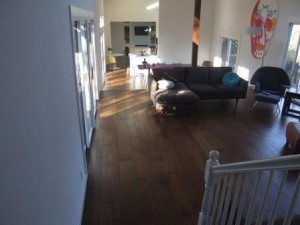
When you think of radiant heating you think of floors, although it can be costly and involves replacing your whole floor or sections of floor. It’s usually only feasible to install in new construction or extensive remodels. But there is another alternative; putting radiant heat in the ceiling or walls is much more cost effective. Furthermore, it actually disperses the heat using the same principle and more effectively. In Europe radiant heating in ceiling and walls has been used for years, especially in bathrooms. And in the last several years placing radiant heat element in ceilings and walls has been increasing in popularity.
In the 1950’s and 60’s radiant floor heating in ceilings was actually very popular in the U.S. As the cost of electricity grew the cost became prohibitive. Since then Climate Panels have been developed. These operate by running warm water through tubes placed on boards under flooring, in ceilings or in walls.
Radiant floors have a couple limitations. First, they can only have a maximum surface temperature of 87F or 45 BTU’s per square foot. As a result, if the floor becomes hotter the homeowner will start to complain of sweaty, hot feet. Secondly, heat resistant floor coverings and some heat resistant wood flooring will hinder radiant heat. Often times people will complain that their radiant ceased working after putting down new carpeting.
Contractor’s place radiant heating elements under the subfloor where there is insulation and other heat dampening material. Radiant heating elements actually work more effectively in ceilings where there is the least amount of buffer material. Also, they can operate at a higher surface temperature of 100F or 55 BTU per square foot, which helps disperse heat quicker.
How Does It Work
Hydronic radiant heat disperses heat in the same way the sun does through heat radiating outwards warming surface temperatures through infrared radiation. Radiant heat operates through convection. This means as the air closer to the floor or other surface heats it rises pushing the cooler air down, which then heats. This disperses the heat more evenly throughout the room, especially when compared to forced air heating.
When placing the heating elements in the walls, they should be placed in a line-of-sight basis. This means you should place them where there is the least amount of barriers between you and the wall. The lower 4 foot section is best, although you can go up to 8 foot walls for higher ceilings. The thickness of the Viega Climate Panel is 5/16″ thick, which should fit fairly easily behind drywall. If this does push the wall out slightly many people cover this discrepancy with wainscotting.
Radiant heating in ceilings work best on flat ceilings between 8-12 feet high. One of the benefits of radiant heat in ceilings is that in warmer months cool water can be run through the pipes acting as a natural air-conditioning convection system. Because there is some humidity with this a using a dehumidifier will work for optimum comfort.
Highly Efficient
Radiant heat has the fastest response time of all heating systems. This and since each room is individually controlled leads to substantial savings in both energy and money. Money and energy is not wasted heating rooms that are seldom in use. Because of it’s energy efficiency hydronic radiant heating will qualify for financing through SCEIP (Sonoma County Energy Improvement Program). To qualify it must be combined with a Energy Star boiler or water heater.
Radiant heat is the most efficient and comfortable heating system available. Now you can still have it even when putting it in the floor isn’t an option. If you are interested in learning more about radiant heating please contact Sun Fire Plumbing. We would be happy to discuss how to make your life more comfortable.

Recent Comments